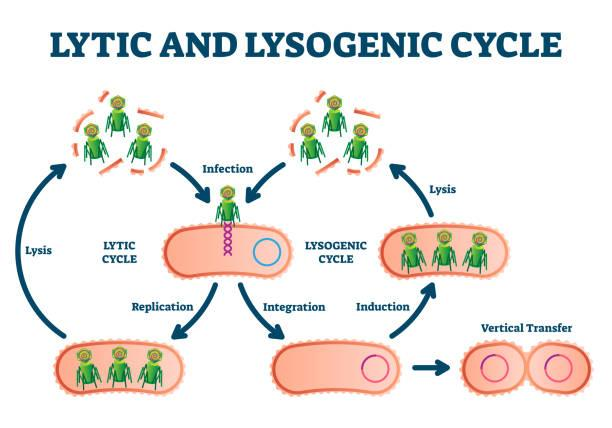
What is the life cycle of bacteria?
Answer
369k+ views
Hint: Bacteria are microscopic single-celled creatures. Bacteria can be found almost everywhere on the planet and are vital to the planet's ecosystems. Some organisms are able to survive at extremes of temperature and pressure.The human body is teeming with bacteria, with bacterial cells outnumbering human cells.The majority of bacteria in the body are harmless, and some can even be beneficial.Disease is caused by a small number of species.
Complete answer:
The lag phase, the log or exponential phase, the stationary phase, and the death phase make up the bacteria's life cycle. This cycle is significantly influenced by factors that drive bacterial growth.
1. Lag phase- During the lag phase, bacteria do not proliferate. They do, however, adapt to their surroundings and metabolise, or generate the vitamins and amino acids required for division. They start generating copies of their DNA, and the lag phase may be quite short if the environment provides lots of resources. The bacteria will then move on to the next stage of their lives.
2. Log or exponential phase- Bacteria reproduce rapidly, even exponentially, during the log or exponential phase. The time it takes for a culture to double is known as "generation time," and it takes place under ideal circumstances.
Bacteria reproduce rapidly, even exponentially, during the log or exponential phase. The time it takes for a culture to double is known as "generation time," and under ideal circumstances.
3. Stationary phase- Bacterial growth slows down during the stationary phase. Bacteria are unable to sustain the log or exponential phase clip due to waste accumulation and a lack of room. However, if the bacteria are transferred to another culture, fast growth may restart.
4. Death phase- Bacteria lose their ability to multiply during the death phase, which is their death knell. Bacterial death can happen as quickly as their growth, much like in the log or exponential phases.

Note:
Factors that influence growth-
Temperature, acidity, energy sources, and the presence of oxygen, nitrogen, minerals, and water all influence bacterial development and hence the life cycle of bacteria. The bacterium determines the best growing circumstances. For example, psychrophiles flourish in frigid temperatures, but hyperthermophiles thrive in hot habitats like ocean vents. Alkaliphiles require extremely acidic surroundings, whereas neutrophils prefer neutral settings. Of course, these are just two examples out of a plethora.
Complete answer:
The lag phase, the log or exponential phase, the stationary phase, and the death phase make up the bacteria's life cycle. This cycle is significantly influenced by factors that drive bacterial growth.
1. Lag phase- During the lag phase, bacteria do not proliferate. They do, however, adapt to their surroundings and metabolise, or generate the vitamins and amino acids required for division. They start generating copies of their DNA, and the lag phase may be quite short if the environment provides lots of resources. The bacteria will then move on to the next stage of their lives.
2. Log or exponential phase- Bacteria reproduce rapidly, even exponentially, during the log or exponential phase. The time it takes for a culture to double is known as "generation time," and it takes place under ideal circumstances.
Bacteria reproduce rapidly, even exponentially, during the log or exponential phase. The time it takes for a culture to double is known as "generation time," and under ideal circumstances.
3. Stationary phase- Bacterial growth slows down during the stationary phase. Bacteria are unable to sustain the log or exponential phase clip due to waste accumulation and a lack of room. However, if the bacteria are transferred to another culture, fast growth may restart.
4. Death phase- Bacteria lose their ability to multiply during the death phase, which is their death knell. Bacterial death can happen as quickly as their growth, much like in the log or exponential phases.

Note:
Factors that influence growth-
Temperature, acidity, energy sources, and the presence of oxygen, nitrogen, minerals, and water all influence bacterial development and hence the life cycle of bacteria. The bacterium determines the best growing circumstances. For example, psychrophiles flourish in frigid temperatures, but hyperthermophiles thrive in hot habitats like ocean vents. Alkaliphiles require extremely acidic surroundings, whereas neutrophils prefer neutral settings. Of course, these are just two examples out of a plethora.
Recently Updated Pages
Master Class 12 Economics: Engaging Questions & Answers for Success

Master Class 12 Maths: Engaging Questions & Answers for Success

Master Class 12 Biology: Engaging Questions & Answers for Success

Master Class 12 Physics: Engaging Questions & Answers for Success

Master Class 12 Business Studies: Engaging Questions & Answers for Success

Master Class 12 English: Engaging Questions & Answers for Success

Trending doubts
Which are the Top 10 Largest Countries of the World?

What is a transformer Explain the principle construction class 12 physics CBSE

Differentiate between homogeneous and heterogeneous class 12 chemistry CBSE

Draw a labelled sketch of the human eye class 12 physics CBSE

What are the major means of transport Explain each class 12 social science CBSE

What is the Full Form of PVC, PET, HDPE, LDPE, PP and PS ?




